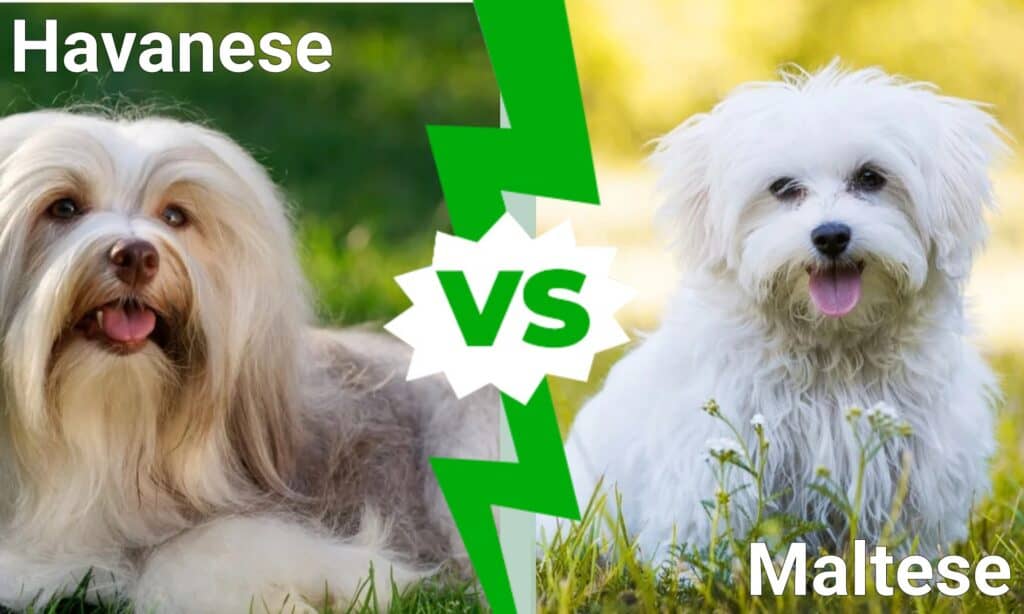If you have always wanted to learn more about different types of lap dogs, what are all the differences between a Havanese vs Maltese? Both of these dogs are toy breeds and beloved for their companionship oh, but what are all of the things that separate them from one another, and what are all the things they have in common?
In this article, we will compare and contrast everything you need to know about Havanese and Maltese dogs. We will go over their appearances so that you can learn how to tell them apart, as well as their size differences. We will also address what they were originally bred for along with their behavioral differences and life spans. Let’s get started and learn all about these two dogs now!
Comparing Havanese vs Maltese

| Havanese | Maltese | |
|---|---|---|
| Size | 8-11 inches tall; 7-13 pounds | 7-9 inches tall; 5-7 pounds |
| Appearance | Long and beautiful fur in a variety of colors and patterns; hair can be straight, wavy, or curly. Tail is plumed and elegant, and their ears are very long | Small and covered in beautiful fur in white shades; fur is straight and silky. Hard to find their ears, as it looks like hair, and stubby snout |
| Originally Bred For | Ancient breed used as a royal lap dog for most of its life | Companionship and rodent hunting; an ancient breed |
| Behavior | Shy and prone to bouts of anxiety and barking; loves their family and extremely easy to train, making them entertaining and fun | Very friendly and compassionate with humans that they know; needs more exercise than you may think |
| Lifespan | 12-15 years | 13-17 years |
Key Differences Between Havanese vs Maltese

Maltese dogs only come in white fur colors, while Havanese dogs come in a variety of colors and patterns.
©Dorottya Mathe/Shutterstock.com
There are many key differences between Havanese and Maltese dogs. For example, Havanese dogs grow larger than Maltese dogs, in both size and weight. Maltese dogs only come in white fur colors, while Havanese dogs come in a variety of colors and patterns. While both of these dog breeds make fantastic home companions, the Havanese is more shy overall compared to the friendly Maltese.
Let’s discuss all of these differences in more detail now.
Havanese vs Maltese: Size

While both of these dog breeds make fantastic home companions, the Havanese is more shy overall compared to the friendly Maltese.
©iStock.com/Mindaugas Dulinskas
No matter what, the Havanese and the Maltese make ideal lap dogs for their sizes, but the Havanese grows larger than the Maltese on average. Either way, both of these dogs are considered toy or small dog breeds, but let’s go over their sizes in more detail now.
The average Havanese grows anywhere from 8 to 11 inches tall, while the average Maltese reaches 7 to 9 inches tall. Additionally, Havanese weigh more than Maltese dogs. For example, Havanese dogs weigh anywhere from 7 to 13 pounds, while Maltese dogs weigh 5 to 7 pounds on average. Maltese dogs can even weigh less than 5 pounds when fully grown, making them significantly smaller than Havanese dogs.
Havanese vs Maltese: Appearance

Havanese dogs weigh anywhere from 7 to 13 pounds, while Maltese dogs weigh 5 to 7 pounds on average.
©Dorottya Mathe/Shutterstock.com
Both Maltese and Havanese are prized for their beautiful appearance and luxurious coats. However, there are some physical differences that separate them from one another. Maltese dogs only come in shades of white, while Havanese dogs come in a variety of colors and markings. But this isn’t where their differences end.
The hair of a Maltese is always straight and silky, while the hair of the Havanese can be straight, curly, or wavy. However, Havanese dogs still have magnificent and long hair, just like Maltese dogs. Another physical difference between these two dogs is that Maltese noses are smaller compared to the elongated snout found on the Havanese.
Havanese vs Maltese: Original Reason for Breeding

Maltese dogs only come in shades of white, while Havanese dogs come in a variety of colors and markings.
©Eric Isselee/Shutterstock.com
Given the sizes of both of these dogs, the original reason that they were bred is similar. Both Havanese and Maltese dogs are considered ancient breeds, bred in Cuba and Malta respectively. Plus, they were both bred as companion animals for royalty or wealthy people originally, though Maltese dogs were also used to hunt rodents on ships, while Havanese dogs were not.
Havanese vs Maltese: Behavior

The average Maltese dog enjoys their family and is relatively friendly to strangers, while Havanese dogs prefer a level of shyness and independence.
©Dorottya Mathe/Shutterstock.com
There are a few behavioral differences between Havanese and Maltese. The average Maltese dog enjoys their family and is relatively friendly to strangers, while Havanese dogs prefer a level of shyness and independence. However, Havanese dogs suffer from more separation anxiety and nervous behavior such as barking compared to the relatively mellow Maltese.
This isn’t to say that Maltese dogs are entirely mellow or laid back. Both the Havanese and the Maltese need ample amounts of exercise in order to enjoy their lives, and the Maltese is regarded as an extremely active breed. Havanese dogs are often regarded as easier to train than Maltese dogs, though it all depends on your training abilities and individual dog.
Havanese vs Maltese: Lifespan

Maltese dogs live longer than Havanese dogs, though their lifespans overlap quite a bit.
©Dora Zett/Shutterstock.com
A final difference between Havanese dogs and Maltese dogs is their life spans. Both of these dogs live incredibly long lives given the fact that they are toy breeds and small, and smaller breeds live longer than large dog breeds on average. However, there are some lifespan differences between these two dogs.
Maltese dogs live longer than Havanese dogs, though their lifespans overlap quite a bit. For example, Havanese dogs live an average of 12 to 15 years, while Maltese dogs live an average of 13 to 17 years. All of this depends on the individual dog and the care that the dog is receiving. Adequate exercise and nutrition is key to ensuring that your Maltese or Havanese live a long and happy life!
The photo featured at the top of this post is © Dorottya Mathe/Shutterstock.com
Ready to discover the top 10 cutest dog breeds in the entire world?
How about the fastest dogs, the largest dogs and those that are -- quite frankly -- just the kindest dogs on the planet? Each day, AZ Animals sends out lists just like this to our thousands of email subscribers. And the best part? It's FREE. Join today by entering your email below.
Thank you for reading! Have some feedback for us? Contact the AZ Animals editorial team.






